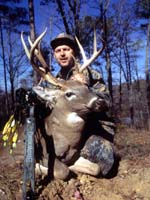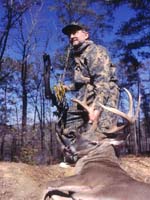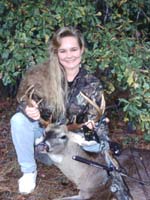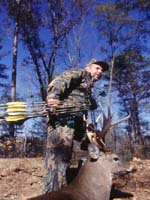
|
Features
|
|
|
|
Books
|
|
|
|
Fun & Games
|
|
|
|
Contact Us
|
|
|
John's Journal... Entry 63, Day 5
Dr. Robert Sheppard
 EDITOR'S
NOTE: Dr. Sheppard of Carrollton, Alabama, lives in the middle of
some of the best deer-hunting country in the South. He actively pursues
many kinds of game year-round and especially enjoys the challenge of hunting
with his bow.
EDITOR'S
NOTE: Dr. Sheppard of Carrollton, Alabama, lives in the middle of
some of the best deer-hunting country in the South. He actively pursues
many kinds of game year-round and especially enjoys the challenge of hunting
with his bow.
I go to the thick-cover areas on the land I hunt during the summer months and move 30 to 40 yards inside a thicket. I cut a small trail to the spot in the thicket I want to hunt. Usually the trail will be no more than two feet wide -- just wide enough for me to walk without my clothes touching bushes and brambles on either side. Then I won't leave very much odor on bushes and trees as I walk.
At the end of the trail in the middle of the thicket, I'll look for a tree to place a tree stand in or a high point where I can set up a ground blind. Then I'll set up my tree stand or build a ground blind and face it northwest by using my compass to increase my odds of having a favorable wind on the day I hunt. The wind in west-central Alabama where I generally hunt blows from the northwest.

I may return to this region just before bow season to make sure I don't have to do any more cutting or cleaning of my shooting lanes. On my way out of the thicket, I'll place two Bright Eyes, which are thumb tacks tipped with fluorescent paint, in trees or bushes about 8 to 10 inches off the ground where I can see them before daylight. I'll put them close to the ground so anyone else who spots them will think they're rabbits' eyes and not trail markers.
If you want to take a trophy buck with your bow in thick cover during gun/deer season, you must be sure no one else hunts your stand site except you. Only by camouflaging the way you go into and leave that thicket can you be certain no one else hunts your late season hotspot.

Experience is the best teacher a bowhunter can have, because a hunter must learn when he should take a shot. But my rule is that when an animal presents me with a good shot that I feel I can put him down with, that's the time I shoot. I don't believe you ever should hurry a shot. However, also I've found that you shouldn't wait on that best shot, because many times deer won't give you the shot for which you're looking. I've waited around for that best shot before, never had it presented to me and watched a nice deer walk away from me.
 Don't
play with a deer, don't watch a deer, and don't take a head-on shot either.
But when you've got a good shot, take the shot.
Don't
play with a deer, don't watch a deer, and don't take a head-on shot either.
But when you've got a good shot, take the shot.
Check back each day this week for more about The Masters' Secrets Of Bowhunting ...
Day 1 -Jim Crumley -- The
Importance of Preparation
Day 2 -Larry Norton
Day 3 -Bob Foulkrod
Day 4 -John Demp Grace
Day 5 -Dr. Robert Sheppard